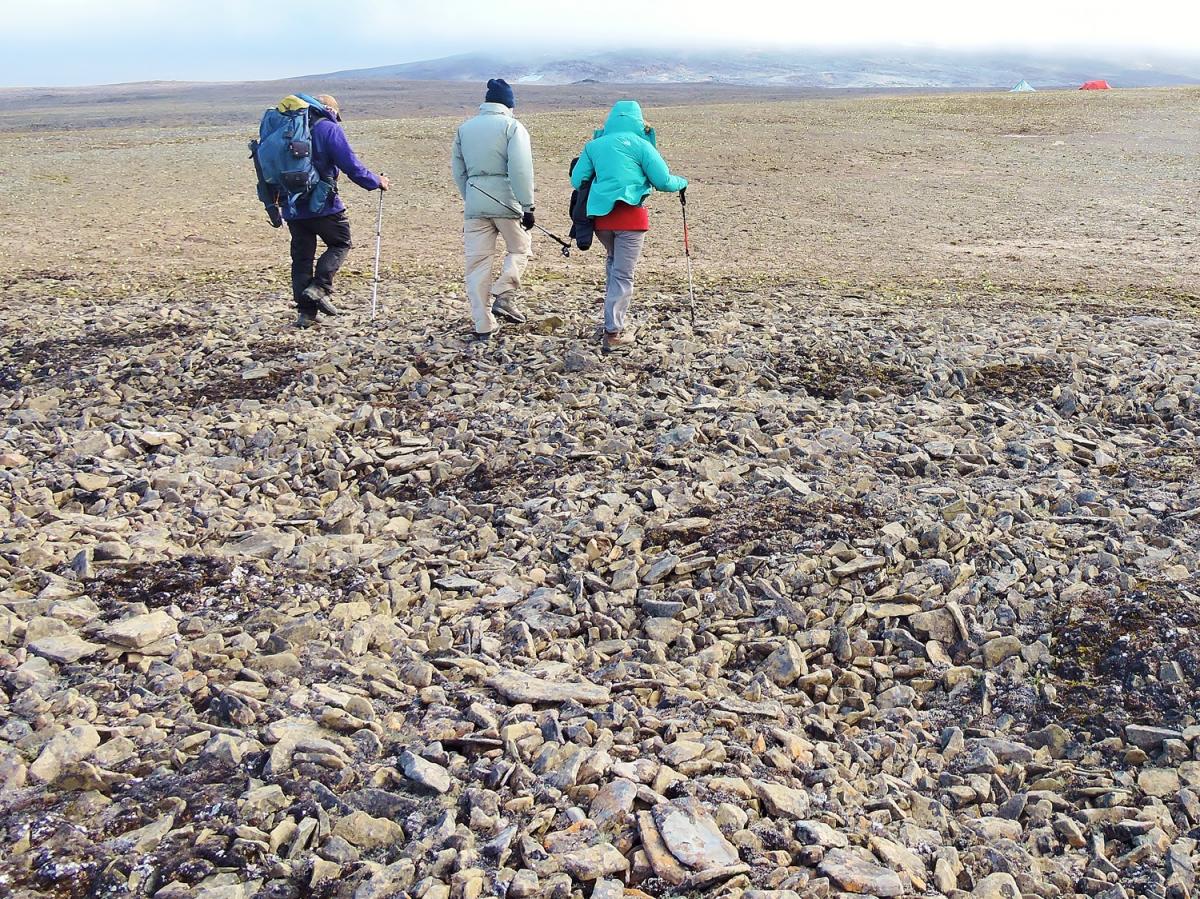 |
| Fellow campers in Qausuittug Park (Photo Marlis Butcher) |
In 2015 Qausuittuq (pronounced cow-soo-ee-took,
meaning “a place where the sun doesn’t rise”) became Canada’s newest national
park. At 11,000 square kilometers, the
park makes up almost two thirds of Bathurst
Island in the Canadian high Arctic. The
park is one of the most challenging to get to, with the nearest access point being
the community of Resolute Bay on Cornwallis Island, just to the east of
Bathurst. In July 2016, three of us took
on that challenge.
Paul and Sue Gierszewski who are trying to visit
all the major parks in Canada, and I, a “Park Bagger” trying to visit all the
National Parks of Canada, made it our priority to become the first ever to
visit Qausuittuq. Together with Dave
Weir of Ice Blink Expeditions, we persevered against the odds of getting to the
park: our attempts to fly via Iqaluit
and Resolute Bay kept being foiled by dense fogs and high winds. Although these standard Arctic travel delays
seriously compromised our window of opportunity, our patience paid off: On
the eighth day of our journey we finally boarded the Twin Otter that would fly us
into the north end of the Park.
Immediately upon landing in Qausuittuq, we
discovered the reason for the park: the
preservation of endangered Peary caribou. They were everywhere. We saw several small groups of two to eight
animals: cows with calves, and bulls. Their velvety antlers glowed in the bright
sunshine; their flanks flashed white as they scampered
across the plains. They were foraging on
the few bits of greenery growing amongst a seemingly never-ending field of
rocks.
A couple of male caribou stopped and stared at
us, and evidently deciding that we weren’t a threat, continued on their way
right across our route. They were grazing
as they journeyed just a few meters before us.
On our part, we too stopped and stared, back at the caribou. We silently watched in awe, respecting their
space.
 |
| Peary Caribou (Photo Marlis Butcher) |
Such beautiful animals. Only approximately 91 centimeters tall at
their shoulders, Peary caribou are small compared to their southern cousins,
the woodland and tundra caribou. Their
petite statures belie their extreme hardiness, being able to comfortably cope in
the harsh Arctic environment.
Temperatures in the few weeks of summer go up
to only around 5⁰
Celsius on Bathurst Island, and there is so little precipitation that the
island is considered to be part of a polar desert. The land that we saw consisted mostly of small
rocks and dried mud flats with only sparse patches of lichens and mosses. We did not even encounter the usual Arctic
plants such as moss campion, broad-leaved willow herb, and arctic willows. There is not much for vegetarians like the
caribou to live on.
We heaved on our heavy backpacks and hiked out
of the gravelly plain on which we had landed.
We slogged through the shallow, snow-melt soggy muck on the edges of the
valley, and onto higher, drier ground. We
set up camp near a clear-running stream, in a pretty field of yellow Arctic
poppies. To be precise, the poppies grew
through the cracks of a dried mud plain, each plant blooming a few feet away
from its neighbour. However, in a place
so devoid of life, a plateau dotted with bobbing colour was a major attraction.
The low rounded mountains of the Stokey Range
rose up around our camp. From a distance
they looked like gentle, easy to climb hills.
As we climbed up one 350 meter rise, we discovered that the hills were
strewn with huge flat boulders interspersed with jumbles of sharp-edged rocks
that threatened us with cuts and sprains.
There were patches of shale shards which slid out from under our feet,
and sand blowouts in which we found chunks of clear quartz. A few patches of snow still clung stubbornly
to the shady side of rocky alcoves – we wondered whether these remnants of last
winter would melt before the end of this summer.
From the top of the mountain we looked out over park. The other valleys between the Stokey
Mountains looked just as broad and barren as the one we were camped in. In the distance, the Arctic Ocean was filled
with broken ice, reminding us to be vigilant of possible wandering, hungry polar
bears. Human beings are not at the top
of the food chain in the Arctic. With no infrastructure, emergency shelters,
or trails on the island, we were extremely aware of how vulnerable we
were. Qausuittuq is very, very remote.
Despite the apparent desolation, our little group
of explorers discovered that in Qausuittuq National Park of Canada, the sun
doesn’t rise in the summer because it never sets; and the sun shines brightly
on the now protected home of the Peary caribou.
Marlis Butcher is a member of The
Explorers Club and serves on the board of directors for the Bruce Trail
Conservancy. She is currently on a mission to visit all of Canada's 47 national
parks. As a
writer, Marlis has published conservation related articles in the “Bruce Trail
Magazine” and travel articles in her neighbourhood’s “Village Voice”
newsletter. This piece was originally
published in Canadian Geographic here.
See Brian Henry’s schedule here, including writing workshops and creative writing courses in Algonquin Park, Bolton, Barrie, Brampton, Burlington, Caledon, Georgetown, Guelph, Hamilton, Ingersoll, Kingston, Kitchener, London, Midland, Mississauga, Oakville, Ottawa, Peterborough, St. Catharines, St. John, NB, Sudbury, Thessalon, Toronto, Windsor, Woodstock, Halton, Kitchener-Waterloo, Muskoka, Peel, Simcoe, York Region, the GTA, Ontario and beyond.


No comments:
Post a Comment
Note: Only a member of this blog may post a comment.